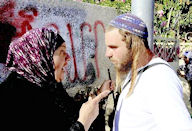The Story of Sheik Jarrah
The Sheik Jarrah district of East Jerusalem can illustrate our dilemma. Sheik Jarrah was built under the British Mandate as a dormitory suburb for prosperous “Arabs”. In the 1930s a number of Jewish refugees, fleeing from Nazi persecution, bought homes in Sheik Jarrah, living happily among their neighbours but, like all refugees, missing their old homes, families, friends, schools and workmates.
In 1948 Sheik Jarrah, along with the rest of East Jerusalem, was occupied by the Jordanian Army. The Jewish inhabitants were expelled, through no fault of their own. Refugees again, they were separated from homes, friends, schools, workmates, and even the ancient synagogues and the Wailing Wall in the Old City of Jerusalem.
 |
Meanwhile desperate “Arab” refugee families, separated from home, family, neighbours, schools and workplaces in Jaffa and Haifa, through no fault of their own, arrived in East Jerusalem, where the Jordanian authorities granted them permission to occupy the vacated Jewish homes, and issued title deeds accordingly.
Then in 1967 the Israeli Army occupied East Jerusalem and Zionist zealots pointed out that, according to Israeli law, those homes were stolen Jewish property. Jordanian title deeds were worthless. The “Arabs” must be expelled, either by legal eviction or by intimidation. For a second time, through no fault of their own, the Arab families became refugees, separated from home, family, neighbours, schools and workmates. | |
In the face of this multiple injustice, what have Quakers to say? A Prophet might seek a global solution. A Reconciler will probably be more sensitive to the distress of individual vulnerable families on both sides. Perhaps this is the spiritual crux of the split between Prophets and Reconcilers. The latter at best long to speak directly to that of God in every person, each, in the words of our Advices, “unique, precious, a child of God”. Prophets, on the other hand, can be at best, in Mendl’s words, “true visionaries, dedicating their lives to one cause or another almost to the exclusion of all else. Their vision, enthusiasm and combativeness (being) tempered by generosity, genuineness and gaiety”.
Can Israeli concerns and Palestinian concerns ever be reconciled?
